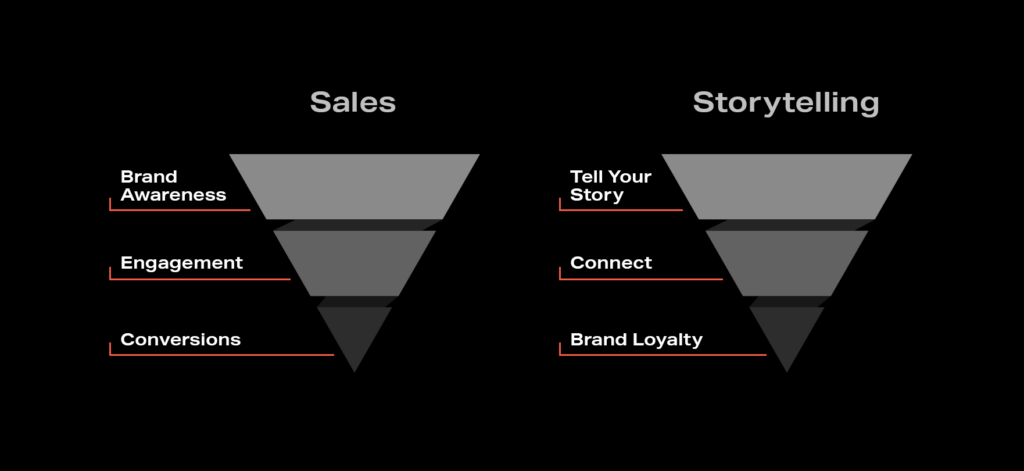Putting your brand out there on social media is sometimes a little more confusing than you’d first think. You want to deliver your brand message but you also want to drive sales. You want people to connect with your values but you also have KPIs to hit. You want to build a nurtured community but you also want to reach everyone, everywhere, all at once. The question is how can you balance storytelling and sales on social media? Let’s dive into the importance of storytelling, how telling a story can support sales, and why incorporating emotion into your messaging might be the key to connecting with your audience.
What do we mean by storytelling and why is it so important?
Less ‘Once upon a time’ and more real-life experiences. Telling a story isn’t make-believe; it’s all about sharing a moment or a piece of information that truly tells your, well, brand story. Something that will connect with others. Simon Sinek said it best with his “People don’t buy what you do, they buy why you do it”. You might be selling something but it’s the messaging behind the product that will resonate with your audience. We’re human first, brand second.
Think of your sales funnel through a storytelling eye – they complement each other.
Top of the sales funnel is to raise awareness – from an emotional intelligence eye, that translates to tell your story.
Next, when you’re making a sale, you’re looking for people to engage. This is also true for storytelling, but let’s call it connection. Values are aligned and the story brings both brand and community together.
Connection leads to loyalty and trust. They trust in your story, they buy into your brand, and in turn buy what you’re selling; that’s the conversion metric.

Questions to consider when telling your story:
- Who are you? Discuss the foundations of your brand, who is behind the idea and how it came to life.
- Why does your brand exist? Where did the idea come from and how did you bring it to life?
- Why is your brand different from others? There is a lot of competition out there but what makes you different from others. What’s your USP (Unique Selling Proposition)?
- How did you get to where you are? A timeline of events, the backstory makes the story.
Values speak volumes
So you’ve begun telling your story, what’s next? Whether you’re communicating your brand pillars or turning heads with your mission statement, brand values are the heart and soul of connecting with others. First step was telling your story, the second is staying true to it.
When creating content, if it doesn’t align with your brand, don’t do it. It can be easy to jump on a trend because everyone is talking about it for the sake of a sale, but if it doesn’t represent your values, it has no place in your storytelling strategy.
Content types to consider when storytelling on social media:
- Define your core values and only create content that relates to them.
- Partner with like minded brands or influencers for an authentic approach. Whether they’re paid or not, a genuine collaboration engages the right audience and opens your brand up to a wider community.
- Show your product in situ as opposed to a direct push for sales. Now they know who you are, showing your audience how to use your product enables them to make their own mind up about your brand.
- Create content that resonates with your brand, as opposed to just being about your brand – think similar themes and topics. For example, does it make sense to create content around someone’s daily rituals, recipe inspiration, or activities that relate to your brand and values, alongside more branded content.
- Include people – whether that’s your team, you, or your audience – people connect with people.
The art of copywriting
Don’t underestimate the power of words. After all, we are still telling a story. Tone of voice is key, and creative copy makes you memorable.
Things to consider when crafting a caption:
- Experiment with short form – one, two, three words can be enough when done well. Information overload doesn’t translate to more sales. Instead, experiment with what you can achieve with a handful of words. We’re thinking teaser copy, brand taglines, key statements.
- Make it emotive – focus on an emotional connection to really resonate with your audience. Swap the corporate jargon for powerful prose. Make people feel something, as opposed to solely actioning something.
- Long form can also leave a lasting impression – especially when telling a story. It’s all about the subject of the content, not the duration. Tell a story of the timeline of your business. The first time you came up with an idea of a product, the reason why your brand gets you excited.
- Personality is everything. Be playful, inject life into your copy, imagine you are chatting to a mate— how would the conversation go?
Next stop, sales
You’ve told your story, you’ve built a community, now let the sales follow. Your sales strategy needs to compliment your story. Here are a few tips for amping up the sales activity while still staying true to your story:
- Consider a remarketing strategy targeting people who have already engaged in your content. Remarket to those who have engaged with or shown an interest in what you are offering. We know they want to see your product or service, so show them more.
- Think about exclusive offerings such as a promo or a freebie that can entice people to get onboard. Give people a taste of the real thing in a way that is exclusive and personal.
- Launch a dedicated sales campaign with a more direct call to action – a campaign that lives in people’s news feeds, as opposed to on your social media pages. This is where you can go strong with a real sales message, while supported by an objective in your chosen platform’s Ads Manager that is going to strategically support your sales goal.
So there we have it, storytelling and sales can definitely coexist in a social media world but execution is everything. Be proud of your story, share it with others, and always be human first. Once you’ve got your story out there, the foundations are in place to strategically increase your sales drive. It really is all about working on connecting before ‘add to cart’. The end.


By leaving a comment you agree with the storage and handling of your data by this website. You can learn more about how we handle you comment information in our Privacy Policy. We are using Akismet to reduce comment spam. Learn how they process your comment data.